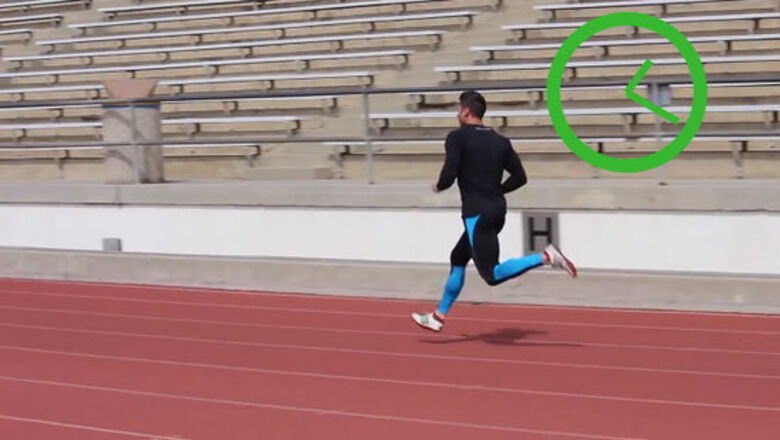
views
Getting Ready for the Sprint
Train for the race. In order to get in shape to compete in the 100m, you’ve got to do some general training beforehand. You need to improve your overall cardiovascular system and do a little endurance training. Generally, you need to improve your overall athleticism. Consider: Implementing a weight training regimen to get yourself in shape. Run distance twice a week to improve your general cardio ability. Make sure to rest 2-3 days in between long-distance runs.
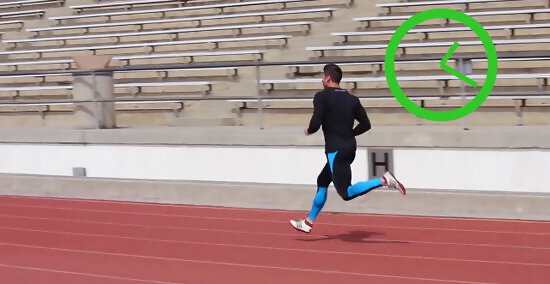
Set a goal. You should set yourself a goal for the time you want to make on the 100m. Don’t set anything way too ambitious, you don’t need to make your mark as a world class athlete just yet. Set something reasonable and something that you would be proud of. A good time for a top competitor is 10 seconds. A good time for a very good high school runner is 12-13 seconds Usually women are about 1 second slower than men. A decent goal to start with might be 15 to 17 seconds.
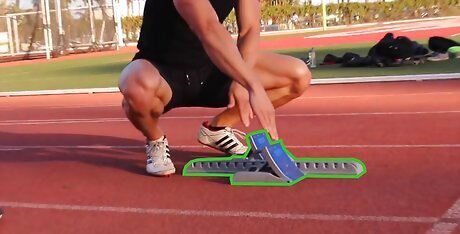
Get your foot blocks to practice your starting stance. Running the 100m requires you starting in a certain stance so that you can propel yourself with maximum force and momentum forward. In order to do this, many coaches and professionals recommend and use foot blocks that are designed for your feet and legs to start in the best position to build momentum. When you get your foot blocks, practice your starting stance: Your front foot will be about two feet from the starting line. Your back foot will be at a toe-to-heel footing in relation to your front foot. Your body will be leaning forward toward the starting line. Your arms will be spread shoulder-width apart from each other. Your hands will be touching the starting line with your index finger and thumb extended onto the line.
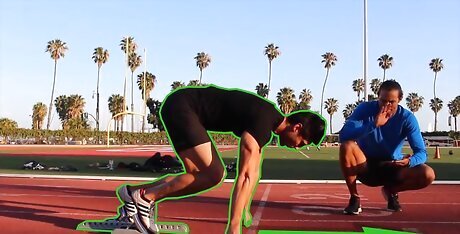
Practice your starting position. Fundamentally, your starting stance and starting technique can cause you to win or lose the sprint. Not only is sprinting more intense, it demands the use of more muscle groups than running, and requires technique so that you can harness your energy and power forward on the field. You need to practice your technique, relying on your starting stance, so that you can build the most momentum going into the race. To start the 100m: Your back leg, which starts off extended, will take the first quick step and come forward. Your front leg will then quickly move forward and propel you forward. Your hips will extend and catapult you upward and ahead.
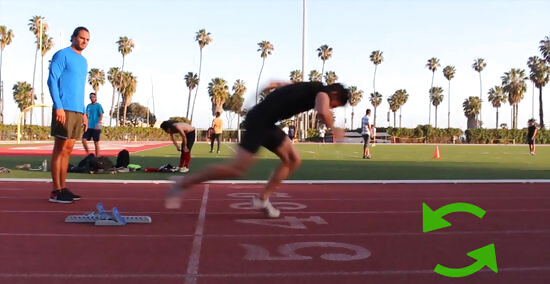
Run practice sprints. After you’ve done some work improving your general shape and set a goal for your 100m, you should begin running some practice sprints. Practicing sprinting will be the only way you’ll actually improve your score. But remember: You should see some improvement after 2-3 weeks. Run practice sprints 3 to 5 times a week. Don’t over practice, your body needs time to rest. Time yourself every time you run.
Getting Rest and Nutrition Before the Sprint

Get an appropriate amount of sleep the night before. Make sure you get a good night’s sleep before the race. Depending on your age and sex, you’ll need between 8 and 9 hours of sleep. After all, being well-rested for the race is fundamental to successfully competing and doing your best. Go to sleep early, so you’ll have plenty of time to prepare the morning before the race. Avoid drinking alcohol the night before. Drinking can cause dehydration, interfere with your sleep, and disrupt your energy balances. Don't oversleep or sleep too much. This might make you tired and groggy.

Eat a good breakfast before the race. While some professional athletes are cavalier about what they eat before a big race, you should eat a well-balanced meal the morning before your run. Don’t overeat, and don’t eat too many sweets or carbohydrates. After all, you want to make sure that your body has everything you need to power through the race without crashing. A vegetable omelet might be a good option. A bowl of cereal with fruit is a good option. Have a glass of orange juice or cranberry juice with your meal.
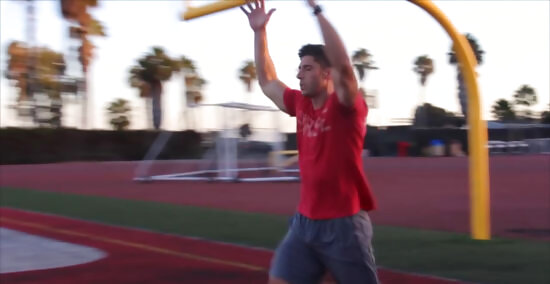
Warm up before the race. Before the race, you want to make sure your body is warmed up. Without warming up, your body will be doing a “cold start” and you might lose precious seconds or cramp up suddenly. One way to warm up is to do a slow jog for 10-20 minutes before the sprint. But don’t wear yourself out, make sure there is plenty of time for you to recover before the sprint.

Drink plenty of water. Water will keep you hydrated before the race. Nothing's worse than getting thirsty after 50m and having to slow down. To avoid this, drink plenty of water. Be careful not to drink too much; don't drink more than a bottle. After you've had a drink, wait about five minutes before running. If you don't, you could feel sick halfway through the race. If you've been feeling dehydrated, make sure you start drinking water at least 1 day before the race.
Racing
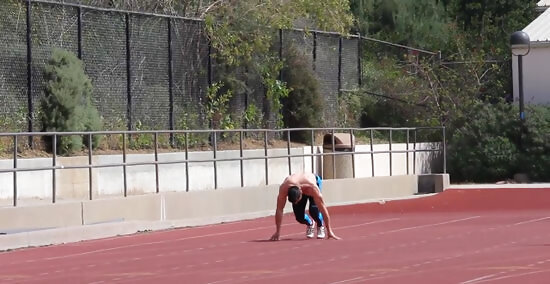
Get a good start. The 100m is one of those events where the start often determines the finish. If everyone else shoots off and you stumble, you probably won't catch up. Getting a good start, then, will give you what you need to both finish decently and to get a good time. Make sure that you get a good kick off of the starting blocks. If you're not using blocks, spring off of your front foot. Once you're moving, power with your arms and cut through the air. Do the same with your legs.

Straighten up during the run. Because you start with your back hunched, you will continue to run that way unless you straighten up. Not straightening up will both slow you down and might lead you to fall down and potentially hurt yourself. Make sure to: Lift up your head about thirty to forty meters into the race. In other words, you should be straight before the second third of the track. Don't look like a pole though, you'll create more air resistance that way. Keep some form of streamlined shape, just not too streamlined.
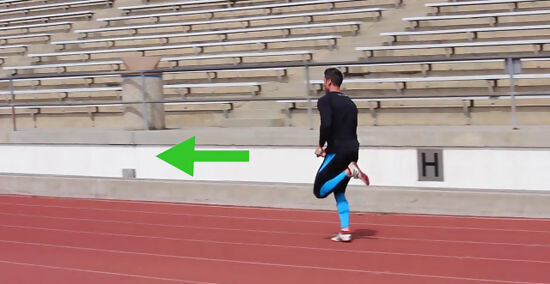
Power through the middle part of the race. In the middle of the race (fifty to seventy-five metres), most people will start to lose their speed. This is because you spent too much of it getting a good start. To have an advantage over all the other runners, keep powering through. If you ever feel tired, look at the finish line. You'll see that it's really not that far away. Keep powering through all the way to the end, don't slow down until you've crossed the line.
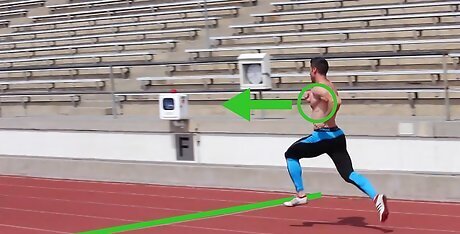
Lunge toward the finish. To shave a tiny bit more time off of your final score, lunge towards the end. As you get better at running the 100m event, you'll get better at judging where and when to lunge. To do the lunge, wait until you've nearly crossed the line. With all the energy you have left, throw your chest towards the finish line. The judges usually stop the stopwatch when your chest passes the line, not head. That's why you want to throw it forward.
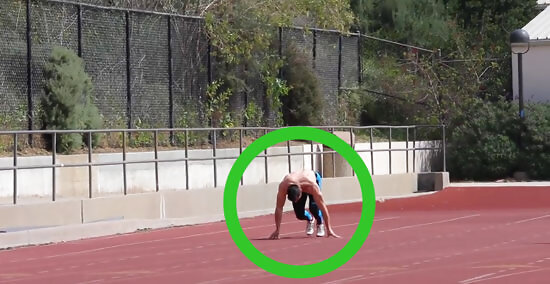
Avoid common problems. There are a number of common issues that trouble many sprinters. If you work to remedy these problems, chances are you'll shave crucial seconds off your time and be a much better sprinter. Make sure to: Work on your coordination. Oftentimes, many runners will begin to lose their coordination and control of their body as they reach their highest speeds after about 50 meters. Work to control your posture, keep your feet flat, and your shin perpendicular to the ground when it touches. Make sure to harness your power and force in a focused manner after the start. Many runners have a problem keeping their running focused at the start of the sprint. Don't panic and just run feverishly -- stay focused on your upright form as you move forward. Don't lunge too soon. If you lunge too soon, chances are you will fall short and lose precious time. The best way to avoid this common mistake is to just practice over and over again.
Improving Your Technique
Take more steps when you sprint. The more steps you take, the faster you'll go. Instead of taking long strides, focus on taking shorter steps as you sprint so your speed increases.
Angle your torso forward. The more your torso is angled forward, the faster you'll run. Even leaning forward an extra 2 degrees can have a big impact on how fast you travel.
Lift your knee up less on your first step. The less you lift up your knee at the beginning of your sprint, the faster you'll go. Practice keeping your knee down as much as possible and see if your speed increases.


















Comments
0 comment